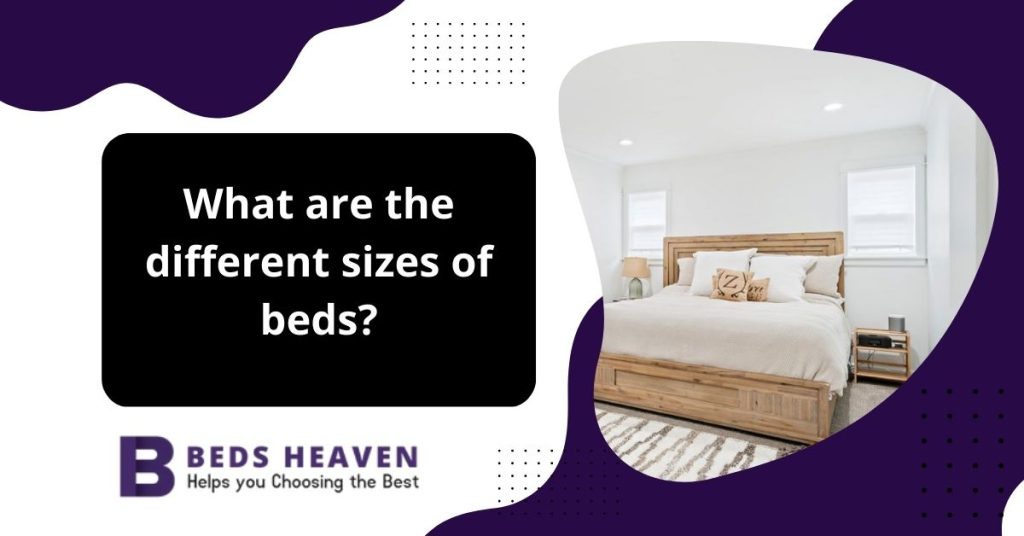Discover What are twin-size queen-size and king-size beds all used for? Learn about their dimensions and the different sleeping arrangements they offer. Choose the best bed size for your bedroom based on your personal preferences and space limitations. Get a comfortable and personalized sleeping experience.
Introduction:
Quick Links
The most common bed sizes in homes are twins, queens, and kings. These beds are suitable for individuals and couples, depending on the size of the room, personal preferences, and intended use of the room.
Twin beds are designed for one individual and are perfect for children, teenagers, and guests. Queen-size beds offer additional space for individuals and are ideal for small bedrooms. The king-size bed is the largest and provides ample sleeping space for couples and individuals.
What are twin-size queen-size and king-size beds all used for?
As a rule of thumb, king, queen, and twin-size beds are commonly found in homes today. These bed sizes are suitable for individuals and couples, depending on the size of the room, personal preferences, and intended use of the bed. When choosing a bed for your home, it is important to understand the differences between each of these bed sizes.

1. Twin Size beds
Twin-size beds, also known as single beds, are designed for one person and are usually the smallest standard bed size. They measure 39 inches wide by 75 inches long, making them ideal for children, teenagers, or guests. In addition to being comfortable for people up to five feet five inches in height, twin beds are a good choice for smaller apartments or rooms.
2. Queen Size Beds
Queen-size beds offer more space for individuals and are suitable for small bedrooms. They measure 60 inches wide by 80 inches long, providing more space for individuals to move around in bed. Couples who prefer more space for themselves without having a large king-size bed are often interested in queen-size beds.
3. King Size beds
The king-size bed is the largest available for couples or individuals who wish to have a spacious sleeping area. King-size beds measure 76 inches wide by 80 inches long, providing ample space for two people to sleep comfortably. For those who wish to have the most room available in their bedrooms or master bedrooms or want the most area, king-size beds are an ideal choice.
What are the benefits of twin-size beds?

1. Space-saving:
The twin bed is compact and occupies minimal space in a room, making it an excellent choice for small bedrooms and shared accommodations.
2. Affordability:
The cost of twin beds is typically lower than that of larger beds, making them an attractive option for those on a tight budget.
3. Versatility:
The versatility of twin beds makes them an excellent choice for growing children or changing rooms. Twin beds can easily be rearranged to fit the layout of a room.
4. Comfort:
It is not uncommon for twin beds to be just as comfortable as larger beds due to the wide range of styles, materials, and designs available.
5. Ease of movement:
Compared with larger beds, twin beds are lighter and easier to move, doing cleaning and rearranging a room easier.
6. Independent sleeping:
The twin beds provide personal sleeping space for each person in a shared room or sleeping arrangement, allowing for a more restful night’s sleep.
Final Words
Twin-size beds offer space-saving, affordability, versatility, comfort, ease of movement, and independent sleeping benefits, making them a good choice for small bedrooms.
What are the benefits of queen-size beds?

1. Comfort:
Providing ample sleeping space and accommodating people of various sizes, queen beds are an excellent choice for couples.
2. Space:
For larger or master bedrooms, queen beds provide more sleeping space than twin or full-size beds.
3. Versatility:
A queen bed can be placed in various room sizes and styles, making it an ideal choice for any decor.
4. Affordability:
A queen bed offers a good balance between price and comfort and is usually more affordable than a king bed.
5. Support:
Queen beds provide good support and comfort for people with varying sleep needs, making them a good choice for couples with different comfort preferences.
6. Style:
You will be able to find a queen bed that matches your style and decor thanks to the wide range of styles, materials, and designs available.
Final Words
As a result, queen-size beds are an ideal choice for couples or individuals who require more sleeping space than a twin or full-size bed. These beds are comfortable, spacious, versatile, affordable, supportive, and stylish.
What are the benefits of king-size beds?

1. Comfort:
The king-size bed provides ample sleeping space for two people, making it an ideal choice for couples who prefer to stretch out while sleeping.
2. Space:
To be the largest bed available, king-size beds are ideal for large bedrooms or master suites.
3. Versatility:
It is possible to arrange king-size beds in various ways to fit different rooms and styles, making them a versatile option for any setting.
4. Support:
A king-size bed offers good support to people with varying sleep requirements, making it a good choice for couples with different comfort preferences.
5. Style:
There is a wide range of styles, materials, and designs available for king-size beds, so you can find one that suits your taste and decor.
6. Luxury:
Luxury and comfort are associated with king-size beds, often viewed as status symbols.
Therefore, king-size beds provide the ultimate sleeping comfort in terms of comfort, space, versatility, support, style, and luxury.
What are the different sizes of beds?

The common bed sizes are:
1. Twin:
With a width of 39 inches and a length of 75 inches, it is ideal for one person and small spaces.
2. Twin XL:
A twin bed measures 39 inches wide by 80 inches long, providing more length than a standard twin bed.
3. Full:
With a width of 54 inches and a length of 75 inches, this bed is suitable for one individual or as a guest bed.
4. Queen:
In terms of size, it measures 60 inches in width by 80 inches in length, making it an ideal choice for couples.
5. King:
In addition to offering ample space for couples or individuals who wish to stretch out as much as possible, the mattress measures 76 inches wide by 80 inches long.
6. California King:
This sofa measures 72 inches wide by 84 inches long for tall individuals.
Final Words
As a final note, bed sizes range from compact twin beds to spacious king beds, so measuring the available space in your bedroom before selecting a bed size is important.
FAQ’s
1. What is a twin-size bed used for?
The twin-size bed usually has a width of 38 inches and a length of 75 inches.
2. What is a queen size bed used for?
A queen size bed can accommodate two people and is usually 60 inches wide and 80 inches long.
3. What is a king-size bed used for?
Two people can also use king-size beds, but they are larger than queen-size beds and measure 76 inches in width and 80 inches in length.
4. What is the difference between a twin, queen, and king-size bed?
There is a significant difference between twin beds, queen beds, and king beds in size, with twin beds being the smallest and king beds being the largest.
5. Who should use a twin-size bed?
Typically, twin beds are used by children, teenagers, or individuals who require a single bed in a small space.
6. Who should use a queen size bed?
In general, queen-size beds are suitable for couples who prefer a spacious bedroom or for individuals who desire additional space.
7. Who should use a king-size bed?
In general, king-size beds are suitable for couples who wish to have the most spacious option in bed and for individuals who wish to have extra space for movement while asleep.
Conclusion
To conclude, twin, queen, and king-sized beds are all designed to serve various purposes based on personal preferences and the amount of space needed for sleeping.
Individual or child-sized twin beds are ideal, while queen-sized beds are appropriate for couples or individuals who require more space, and king-sized beds are suitable for couples who require the most space.

